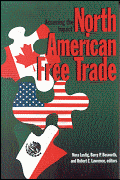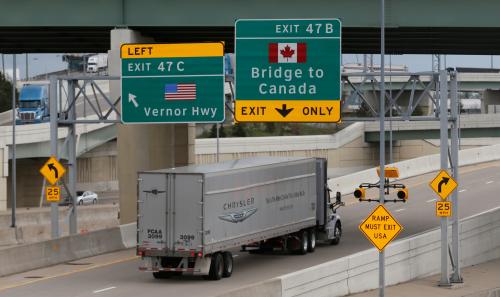With the 2016 election behind us and a Trump administration preparing to transition into power, it is widely expected that changes in trade policy are on the way.
Trade deals were a more prominent campaign topic that at any time in a generation, with populist movements within both parties capitalizing on apprehension about free trade and a growing sentiment that trade deals like the North American Free Trade Agreement (NAFTA) have left American workers behind. Indeed, Mr. Trump made campaign promises to scuttle American involvement in NAFTA and the Trans-Pacific Partnership (TPP), and to pursue a more protectionist trade policy with China.
But what do the independent data and research tell us about free trade, and what it actually means for American workers? In several new policy briefs and posts, Brookings experts have addressed these questions and others to help provide guidance for the new administration. Below are five facts derived from their research about the current state of free trade in the U.S.
1. The U.S. has been running a trade deficit since the 1970s—but that’s not necessarily a bad thing.
Except for a brief period in the early 1990s, the U.S. has been running a trade deficit since the 1970s. Though the deficit is commonly written off as evidence that the U.S. is made worse off by trade, Joshua Meltzer, a senior fellow in Global Economy and Development, argues that there’s more to the story.
Over the past 30 years, Melzter explains, a widening U.S. trade deficit has been correlated with rising GDP and lower unemployment—which Meltzer argues is associated with the economic impact of capital inflows into the U.S. These inflows, he says, “reflect confidence in the U.S. economy as foreigners demand U.S. assets such as bonds, equities, and real estate.” Yet capital inflows,” he notes, “put upward pressure on the dollar and on U.S. asset prices, making imports cheaper and exports less competitive which widens the trade deficit.”
2. Greater reliance on imports is not correlated with unemployment, and trade agreements like the TPP can have a net positive effect on jobs.
Both Meltzer and Foreign Policy Senior Fellow Mireya Solís point out that international trade has had a positive impact on overall U.S. job growth, and that the TPP could continue that trend. The TPP specifically, notes Solís, is estimated to result in a net positive (albeit small) effect on job creation and wages: 128,000 jobs, and increases in real wages (0.19 percent) by 2032.
Moreover, Solís points out that under the TPP, annual increases in real income for Americans (i.e., an expansion in their purchasing power) are estimated to range from $57 billion to $131 billion by 2032 (compared to the baseline scenario without the TPP).
3. Technology, not international trade, is the primary force behind lost manufacturing jobs.
Many are quick to blame trade for a loss of jobs in the manufacturing sector, yet Solís affirms that the predominant force behind losses in manufacturing employment has been technological change (85 percent), not international trade. As she explains, automation has transformed the American factory, and the advent of new technologies (like robotics and 3D printing) has rendered many low-skilled jobs unnecessary.
Metropolitan Policy Program Senior Fellow Mark Muro also examined this trend in a recent post, pointing out that the total inflation-adjusted output of the U.S. manufacturing sector is actually higher today than it has ever been, even though the sector’s employment growth has remained relatively stagnant.

“These diverging lines—which reflect the sector’s improved productivity—highlight a huge problem with Trump’s promises to help workers by reshoring millions of manufacturing jobs [by renegotiating trade deals],” Muro argues. “America is already producing a lot. And in any event, the return of more manufacturing won’t bring back many jobs because the labor is increasingly being done by robots.”
And Solís agrees: “Simply put, we are producing more with fewer people.”
4. Services are the most significant drivers of the U.S. economy and are an increasing component of international trade.
“There is little mention in current trade debates,” Meltzer points out, “of the gains to the U.S. from expanding services trade.” Services, he says, comprise over 80 percent of U.S. GDP, and in 2014 alone the U.S. exported $710.6 billion in services and imported $477.4 billion in services, producing a $233.2 billion surplus. The services trade surplus is also growing, up from $84.8 billion in 2004.
5. NAFTA is mutually beneficial to the U.S., Mexico, and Canada, and weakening it could lead to unintended consequences.
While on the campaign trail, Donald Trump labeled the North America Free Trade Agreement (NAFTA) “the worst trade deal ever signed.” But according to Foreign Policy Senior Fellow Vanda Felbab-Brown the benefits of NAFTA—and the risks of weakening or repealing it– are significant for the U.S., Mexico, and Canada.
In addition to “both basic facts and overwhelming evidence from economic studies” chronicling the economic benefits of the agreement for all three member nations, Felbab-Brown argues that renegotiating NAFTA could also have unintended effects on crime and immigration. “Not only is U.S. security enhanced by good cooperation with Mexico,” Felbab-Brown says, “but weakening U.S.-Mexico economic integration can exacerbate both criminality in Mexico and outmigration pressures to the United States.” Weakening NAFTA, she warns, “would likely result in more impoverished Mexicans seeking to enter the United States illegally to make basic ends meet or face pressures to work in illegal economies and join criminal groups.”
MORE ON TRADE FROM BROOKINGS
Watch experts on both sides of the trade debate address whether or not trade deals benefited American workers in the most recent Brookings Debate.
Listen to Mireya Solís make the case for the Trans-Pacific Partnership on the Brookings Cafeteria podcast.
Read Mireya Solís’ latest take on the future of the TPP under the Trump administration.
Joshua Meltzer explores the paths forward for trade under President Trump.








Commentary
What is the future of free trade? 5 facts about US trade policy
November 18, 2016